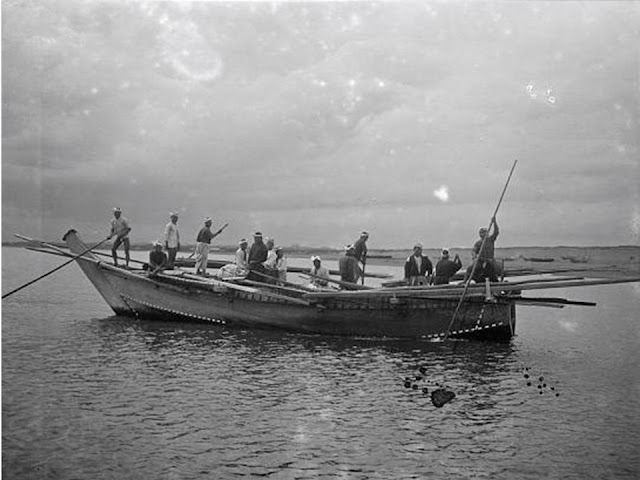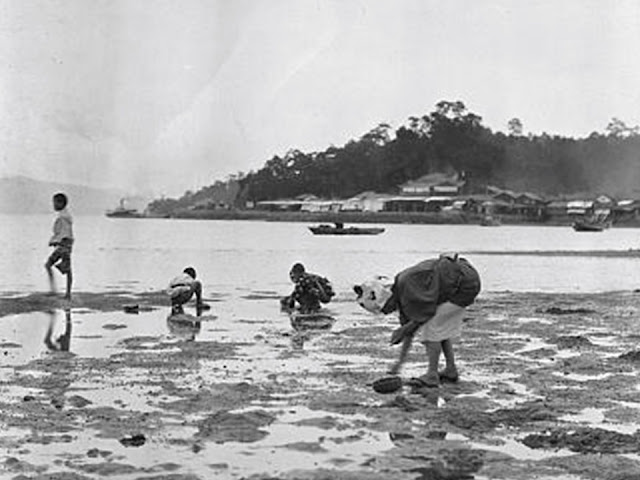人の楽しみの発見度:Very Good ★★☆
村の民俗(民俗民芸双書89、岩崎美術社、1982)に掲載
In the part2, I highlight fun things in a fishing village which
is the theme of this blog.
ここからは、本ブログのテーマである漁村ならではの「日々の楽しみ」についての記載を中心に紹介します。
Contents、目次
(2)Fisher and sea、漁家と海
Marine resources and fishing rights are written in this chapter. A
fishing right is basically belonging to a village. A fishing season was
scheduled like today in order to grow fishes and seaweeds. The fishers
were so excited at the starting date; it is described as follows.
The work on the starting day was the most fun. After fishers endured
to stop fishing there for several months, they caught fishes in a bountiful
sea. The catch of the day was equal to it of a month. It’s natural that they
were serious, competitive and full of excitement, moreover, the author felt the
instinctive delight of fishers. Btw, it was a disadvantage for women in around
the time of childbirth. In Shima of Mie Prefecture, woman divers gave an
abalone to each of them.
The author also wrote her experience of wild vegetable picking and
how enjoyable it was as follows. It’s impressive.
“I went deep into a mountain in spring or in autumn, picked up warabi
plants, or gathered chestnuts in the great nature. It trembled my instinct with
joy and content. I wonder if the feeling would the trace of the gathering period.
It probably developed into hunter’s spirit or fisher’s one, therefore, even if
people work as a salaried fisher, their primary courage (excitement) never
declines.” The delight of fishing or gathering, which is different from it of cultivating (faming), is
well written. The author was born in an ex-samurai family, however she knew the
delight of gathering wild vegetables, so she could write it vividly.
https://www.loc.gov/pictures/collection/agc/item/2018719608/resource/
海の資源と権利について書かれています。個人の権益になっていた漁場もありましたが、漁場は村のものでした。今と同様、魚貝や藻類を繁殖させるため、漁期を決めていました。漁の開始の時(口明けの時)の漁は、「見ていても全身の血がおどるような勇ましさ」だったそうです。漁師たちの興奮が書かれています。
「口明けの日には、数ヶ月間手をつけずに育てた場所から採るのであるから、採取者としてこれほど愉快な作業はありますまい。口明けの日一日の収穫と後の一ヶ月の収穫が匹敵するともいい---真剣夢中になるのも当然であるが---競走心の一面には、---本能的な歓喜の姿が眺められる」と記しています。なお、出産前後の婦人は不利なので、志摩の海女仲間では、産後の婦人には鮑を一つずつ送ったそうです。
この項の冒頭に書かれている著者の野草とりの思い出が印象的で、採集の楽しみを謳歌するすごい文が続きます。「---春秋の深山に分け入って、大自然の懐から蕨を採り、栗の実を拾う時のあの心のときめきは、本能をゆすぶるあの強い歓喜と満足感は、農耕以前の採集生活の名残であろうか。この気持ちはやがて、山に獣を追う狩人や海に漁(すなど)る漁人の生活の根底をなすもので、たとえ舟子が月給制度になっても、採取者の原始的な勇猛心はにわかに衰えるものではなかろうと思われる」。農耕栽培とは異なる労働の喜びが書かれています。著者は武家の生まれですが、採集の喜びを知っているので、漁師の様子も生き生きと描けます。
(3)Colleagues、漁労仲間
Fishermen
retired before around forty-five back then; it was a big difference compared
with farmers. Their bond was strong. They ate and drunk a lot; they
gathered and drunk after a good catch AND after a poor one. They also stayed at
a port and drunk during stormy weather. I have an impression that fishermen
generally drink a lot even now.
Btw, the
character of fishermen was influenced by the way of fishing a lot. In a seine
fishing village, people were something loose; they were not so interested in
the fish price, plus they generously gave fishes to the author. On the other
hand, in a pole and line fishing village, people handled even a fish carefully.
I cannot agree more; the human nature is decided by their occupation.
Fishing village of Obatake on the Inland Sea--looking north to the terraced rice-fields, Japan (1904)、明治37年の漁村と段々畑 https://www.loc.gov/item/2020684919/
当時の海上の仕事は45、46歳が限度で、農家とは大違いでした。仲間内の結びつきは濃く、飲食消費も多く、豊漁につけ不漁につけ、集まって一杯やろうという機会に恵まれていました。時化で漁に出られない日もありますからねえ。今でも、漁師さんはよく飲むという印象があります。
ところで、房総の布良での取材では、釣り漁の村では一匹の魚も惜しむが、網漁の村(布良)では、大漁の時には魚をどんどん人にあげるし、値段も組合任せにしていた、と書かれています。漁の仕方で気質も変わるのですね。これはよく分かります。今も、職業で気質が違います。
(4)Taboo、漁村の禁忌
There were many taboos among fishermen
because of their dangerous work. Moreover, they relied on luck for a big catch. In Maiduru of Kyoto
Prefecture, fishermen didn’t move fishes to the other ship in order to keep
luck (fishes) in their ship. On the other hand, in Fukuoka Prefecture,
fishermen asked the other group who achieved a big catch to have a drinking
party. The purpose of the party was to receive their luck. It worked and the
catch increased. Diverse practices in various areas are written.
In Onagawa of Miyagi Prefecture, women
gifted sake (alcohol) to a head of fisherman's group when a poor catch
continued. They drunk it and dance to pray for a good catch. In Chiba
Prefecture, when fishermen couldn’t go fishing because of a bad current,
elderly women went to a beach, danced and prayed for a good catch.
People in fishing villages had a mind
to accept the distribution of the nature, not to be afraid of lack of savings,
and to concede “tomorrow is another day”. It was said wives were extravagant,
were poor at planning ahead, treated someone generously but pawned even
kitchenware sometimes. It’s a part of fishers’ character.
The
author who was born in a mountain village wrote people in fishing villages
seemed to be franker than ones in farming villages, their voice was
high-pitched, they seemed to be wild but friendly.
命の危険がある漁師には禁忌が多くありました。また、大漁を狙いツキを大切にしました。京都府東大浦(現舞鶴市)では、幸が移るといって、船から船へ魚を移しませんでした。一方、福岡県野北地方では、不漁の船が豊漁の船に酒盛りをしようと持ちかけました。不漁の船に幸が移り、漁が増えたという例が多いそうです。各地の船同士の慣習が書かれています。
漁村では、不漁続きの時は女性が漁主に五合ぐらいの酒を贈り飲んで歌舞したり(宮城県女川町)、海潮が悪く漁がない時は、ばあさんたちが浜辺に出て踊って(千葉県)豊漁を願いました。
漁師には「大自然の配給に甘んじて、貯えがなくても心配せず、明日は明日の風が吹く、という気持ち」がありました。漁家の妻は、金遣いが荒く、家計の計画性がなくて、気前よく振る舞うが、金がない時はお釜まで質に入れるといわれたそうです。これも漁師気質です。
山村育ちの著者は、「漁村の人は農村の人よりもカラッとしている。声が高く、物言いが荒っぽいが、つきあい易い、という感じを与える」と書いています。
(5)Sea lovers、海を愛する人たち
An
old woman in Bosou of Chiba Prefecture said, she liked diving to catch seafood,
so she did it every day until fifty-eight; she left her grandchild at an
acquaintance for thirty sen (not a big cost) a day and dived. The other
old woman also said, she loved the shore so much and dived from nine years old
to sixty-nine; even eleven days later after giving birth, she did.
An
eighty-one years old woman in Izumozaki of Niigata Prefecture talked, she felt
worse when she couldn’t see a fish throughout the day; she went to a fish market
everyday although her offspring told her not to do. She said, "I am happy
whenever I touch fishes", and smiled.
The author mentioned, she was just an alien among the energetic sea-lovers in fishing villages, despite her knowledge of people's lives in their villages. They loved sea itself, loved working there, and felt closer to marine creatures. She expected that the cheerful fisher-women would create the future of the fishing villages.
https://www.loc.gov/pictures/collection/agc/item/2018719957/resource/
房総の老女は、「私は潜りが好きで58歳まで毎年欠かさずに潜った。---孫を一日三十銭で人に預けて海に入った」と言い、他の老女は「私も磯が好きで好きで、九つの歳から69歳まで潜ったよ。産後11日たたぬに潜ったもんだねえ」と言いました。(11日は出産の穢れが明ける日かもしれません)
新潟県出雲崎の81歳の女性は、「毎日、魚の顔を見ないと気持ちが悪くて、若い者らがよせよせというてもまだ毎日市場に行っている。魚さえいじっておれば気持ちがよい」と頬をほころばせました。
著者は、「---訪れた漁村の数は少なくないが、こんなにも海を愛し、海の働きをたのしみ、魚に親しむ人たちの愛情と元気の前には、一言の価値もない他者に過ぎない。」と舌を巻き、漁村の前途は、この愛情とこの元気に満たされた婦人たちに期待しなければならないと記します。
The lives of people in fishing villages at that time were not easier
than of today, plus it was a war time. However, they earned a livelihood,
enjoyed lives by eating and drinking while gathering, and relieved their
stress. More than anything, their love for fishing and sea enriched their lives,
I think.
今と比べると、日々の暮らしは楽ではないし、戦争の時代でした。でも、生業を立て、何かにつけては集まって飲食しストレスを発散させました。何よりも、漁と海が好きだということが彼らの人生を豊かにしたのだと思います。
Previous post: Life in a fishing village and the role of women (published in
1946) (1/2)、漁村の生活と婦人の役割 part1
Next post (Museum in northern Kyushu which is one of four main islands of Japan): Kyushu National Museum、九州国立博物館





Comments
Post a Comment